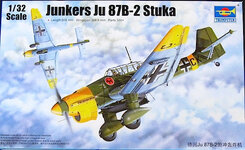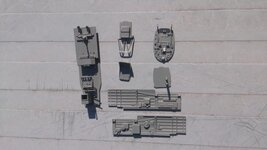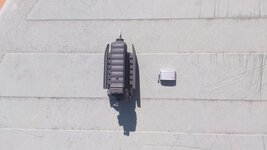Ok let's get this over with...

the sources that say / prove :
RLM 02
- The Spanish 1938 111E looks to have 02 (light grey, really). So it seems probable that at one point indeed the (early) Luftwaffe bombers were 02.
-
http://www.britmodel...ockpit-colours/ : someone says "before 1941: 02. After 1941: 66".
-
http://www.swannysmo...m/Painting.html: He111 Al B1 C1 Dl El Fl G1 J1 Pl H-1 thru H-5 series: Cockpit areas are RLM Green-Gray 02. He111 H 6 thru H 23/R/Z(zwilling) series: Cockpit areas are RLM Black-Gray 66
- The booklet "Luftwaffe Colors 1935-1945" by E. Brown Ryle III says: "RLM 02: (...) used as color of aircraft interiors, cockpits, wheelwells, and landing gear throughout most of the war. (...) As it was produced and used both internatlly and externally throughout the Luftwaffe's existence, it may be "the paint of the Luftwaffe."
- Heinkel He 111 Photo Archive (Airdoc) P17 shows a P which almost surely has a 02 cockpit (b&w).
- Heinkel He 111 Photo Archive (Airdoc) P27 shows a P which looks to have a 02 cockpit (b&w).
RLM 66 cockpit and bomb bay, RLM 02 rest of interior
-
http://www.warcolorphotos.com/407-heinkel-he-111 looks cockpit 66, bomb/radio rooms unknown; however the 111 type and build date is unknown.
- Restored Gardermoen P-version has a 66 cockpit, 66 bomb racks, apparently a 02 bomb bay room (!), 02 radio room and 02 landing gear bay. Very most probably, the restorers have been influenced by the RLM instructive "everything that the pilot sees has to be painted 66". Pilot can see the bomb racks but not the rest of the bomb bay room.
- D.B. Andrus' link a couple of posts above this one looks 66. Bomb/radio rooms unknown.
-
http://www.britmodel...ockpit-colours/ : someone says that "before 1941: 02. After 1941: 66" is wrong, being that all P's have 66.
-
http://www.britmodel...ockpit-colours/ : someone says "A friend of mine had a book about Luftwaffe colours, and it had in it a copy of an RLM directive from mid 1940 (if I remember correctly) stating some thing along the lines of... "...all areas of the cockpit visible to the pilot are to be painted RLM 66 Schwarzgrau..."
- Kagero (Red Series Kagero Decals) shows a 66 interior at the front page, as well as 66 cockpit interiors in the 3 model drawings and probably 02 in the radio room.
- The booklet "Luftwaffe Colors 1935-1945" by E. Brown Ryle III says: "66 Interior cockpit color, including canopy framing, from 1940 to end of war. Used externally in various roles on various types of aircraft. Also allowed for substitute use on spinners (instead of RLM 22), propellers (instead of RLM 70), landing gear wheels (rims) and external repairs in later stages of the war when fighter production increased."
- Although very difficult to see, it seems that on page 322 of the book "Luftwaffe Cmouflage and Markings 1933-1945 Volume 2" there's a 66 cockpit colour P-version.
- The picture at P65 below of "Luftwaffe Camouflage and Markings 1933-1945 Photo Archive 1 showing a juni/july 1940 111H clearly shows 66. It's a night bomber though. But still.
- The picture of a 111P cockpit in "Luftwaffe Camouflage and Markings 1933-1945 Photo Archive 1" P132 looks like it's 66 although it's not clear. There are some lighter parts (black-white photo) but that could be the sun. Comparison with picture on the previous side, a Ju52 cockpit from the 30s, shows that the Ju52 looks lighter overall. I'd reckon 70% chance for the P cockpit to be painted 66.
- Luftwaffe Camouflage and Markings 1933-1945 Photo Archive 1. P136 about the Ju87

"The Ju87B entered service in 1938 (...) Interestingly, none of the identifying colours had been added to the rim of any instrument, nor had the instrument maintenance system of letter/number symbols been added to the instrument panel, indicating that this was probably one of the early B model machines. By 1938, internal colouring for military aircraft was RLM 02, although the type, but not colour, of lacquer was changed that same year (see Volume One, page 207). This cockpit is clearly 66 (although b&w-picture).
- Same book, page 141, regarding another plane type but still interesting and relevant: "The interior of the Si 204 (...) colouring was 02". It's a non-cockpit picture. The Siebel was produced from April 1942, being sufficient proof for me that also in the later war years 02 was used for non-cockpit interior. Next page shows a Si 204D instrument panel part in 66.
- Heinkel He 111 Photo Archive (Airdoc) P13 shows a P-1 which seems to have 66 cockpit.
- Heinkel He 111 Photo Archive (Airdoc) P29 top shows a P which looks to have a 66 cockpit (b&w).
- The RLM directive of 1941 should perhaps not be seen as a changing document. No earlier versions of the directive are known; the year of issue of the 1941 version is erroneously named "1938". It is well possible that also the earlier planes would have 66 as interior colour. The 1941 directive could be 'codification' of existing practice.
So it seems that
- the safest choice for a P-version would be a 66 cockpit, 66 bomb bay and 02 further interior - just like the restored Norwegian specimen.
- full 02 would also be realistic.
- the P could be considered as a transition model.
Hopefully this information gathering is useful for someone beside myself

 tjes:
tjes:




 GRTZ
GRTZ
 tjes:
tjes:




 GRTZ
GRTZ


 the sources that say / prove :
the sources that say / prove : "The Ju87B entered service in 1938 (...) Interestingly, none of the identifying colours had been added to the rim of any instrument, nor had the instrument maintenance system of letter/number symbols been added to the instrument panel, indicating that this was probably one of the early B model machines. By 1938, internal colouring for military aircraft was RLM 02, although the type, but not colour, of lacquer was changed that same year (see Volume One, page 207). This cockpit is clearly 66 (although b&w-picture).
"The Ju87B entered service in 1938 (...) Interestingly, none of the identifying colours had been added to the rim of any instrument, nor had the instrument maintenance system of letter/number symbols been added to the instrument panel, indicating that this was probably one of the early B model machines. By 1938, internal colouring for military aircraft was RLM 02, although the type, but not colour, of lacquer was changed that same year (see Volume One, page 207). This cockpit is clearly 66 (although b&w-picture). 